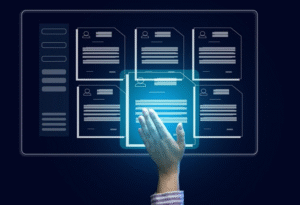Blockchain for Digital Identity: 10 Powerful Benefits in 2025
Understanding Blockchain’s Role in Digital Identity
Blockchain for digital identity is a system that uses distributed ledger technology to give individuals control over their personal information while providing secure, verified digital credentials. Rather than storing identity data in centralized databases vulnerable to breaches, blockchain creates a tamper-proof foundation for identity management.
Here’s what you need to know about blockchain-based digital identity:
| Key Aspect | What It Means |
|---|---|
| Self-Sovereign Identity | Users own and control their identity data, sharing only what’s necessary |
| Decentralization | No single entity controls the entire identity system |
| Immutability | Identity credentials cannot be altered once verified and recorded |
| Privacy | Zero-knowledge proofs allow verification without revealing actual data |
| Interoperability | Works across different platforms and services |
Traditional identity systems have significant problems. Approximately 1.1 billion people worldwide lack any legal form of identity, preventing access to basic services. Meanwhile, those with digital identities face increasing security risks – 97% of data breaches in 2018 targeted personally identifiable information (PII), exposing 2.8 billion consumer records at a cost of more than $654 billion.
Blockchain addresses these challenges by creating a trust layer where:
- Individuals control their own data through private keys
- Identity claims are verified by trusted parties
- Verification happens without exposing sensitive information
- The system works without relying on a central authority
As World Economic Forum researchers put it: “Blockchain has allowed us to take a completely different approach to digital identities that better protects private information and gives users higher control over their data.”
Instead of our current fragmented approach where each service maintains its own identity database, blockchain creates a unified, secure foundation where identity becomes portable, private, and user-controlled.

What Is Digital Identity and Why It Matters
Think about all the ways you prove who you are online – your email address, social media profiles, government IDs, and even your shopping preferences. Together, these elements form your digital identity – the virtual version of “you” that exists in our connected world.
Your digital identity includes all your personal identifiable information (PII), the websites you visit, the devices you use, and the credentials that verify you’re really you when logging into different services.
This digital version of yourself matters more than you might realize. Right now, about 1.1 billion people worldwide lack any form of official identity, which means they’re essentially invisible to formal systems. Without a digital identity, these individuals can’t open bank accounts, access healthcare, receive education, or claim government benefits.
The World Bank’s ID4D research indicates that establishing robust digital identity systems could generate economic value equivalent to 3-13% of GDP in developing countries by bringing more people into the financial system and reducing fraud. That’s an enormous potential for positive change!
Core Components of a Digital Identity
Your digital identity isn’t just one thing – it’s a collection of different elements working together:
Identifiers serve as your unique digital addresses – like your email, username, or more technical solutions like Decentralized Identifiers (DIDs). These distinguish you from everyone else online.
Credentials are the digital equivalent of your physical documents. These verified claims about you – from driver’s licenses to university degrees to professional certifications – tell others what you’re qualified to do.
Biometrics add a layer of security using your unique physical or behavioral characteristics. Your fingerprint open uping your phone or facial recognition verifying your identity are perfect examples of biometrics in action.
Metadata might be invisible to you, but it’s crucial – this information tracks when and how your identity data gets used and by whom, creating an audit trail of your digital existence.
Traditional systems scatter these components across dozens of databases, creating fragmentation that blockchain for digital identity solutions aim to solve.
Key Stakeholders
The digital identity ecosystem involves four main groups, each with their own priorities:
Individuals like you and me need secure, convenient ways to prove who we are online without exposing ourselves to identity theft or unnecessary privacy invasions.
Organizations including banks, retailers, and government agencies need reliable ways to verify identity to prevent fraud while providing seamless customer experiences.
Devices might seem surprising as stakeholders, but in our IoT world, the smart devices in your home and office also need secure identities to ensure they’re communicating with legitimate networks.
Authorities such as government agencies, universities, and certification bodies serve as trusted issuers of credentials that form the backbone of our identity systems.
The challenge has always been creating identity solutions that balance the needs of all these stakeholders – providing security without sacrificing convenience, ensuring privacy while enabling appropriate verification. This balancing act is precisely where blockchain for digital identity offers promising new approaches.
Roadblocks of Traditional Identity Systems
Traditional digital identity systems come with a host of problems that affect us all – creating headaches, security nightmares, and unnecessary complications in our digital lives:

Security & Privacy Risks
Let’s face it – the centralized approach to identity management is like putting all your eggs in one basket, then leaving that basket in a busy public square.
When a company stores thousands or millions of user identities in one central database, they’ve essentially created a treasure chest for hackers. These single points of failure mean one successful breach can expose countless identities simultaneously. The numbers are staggering – in 2018 alone, hackers exposed 2.8 billion consumer records, costing an estimated $654 billion in damages.
Beyond the immediate financial impact, organizations face severe penalties for mishandling your personal data. Under GDPR, companies can be fined up to 4% of their global annual revenue or €20 million (whichever hurts more). Marriott learned this lesson the hard way when they faced a £99 million fine after exposing 339 million customer records.
What makes this even more frustrating is that many systems still rely on outdated security measures. As one security expert perfectly put it during a recent breach investigation: “Traditional identity databases aren’t just targets; they’re treasure troves for attackers, containing everything needed for comprehensive identity theft in one convenient location.”
For more ways to protect yourself, check out our guide to essential Cybersecurity Tools.
User-Experience Friction
Beyond the scary security issues, traditional identity systems create daily annoyances that waste our time and test our patience:
Password fatigue is real – the average person now juggles over 100 digital accounts, each potentially requiring unique login credentials. We’re forced to choose between convenience (reusing passwords) and security (creating unique ones), with neither option being ideal.
The repetitive KYC processes are particularly maddening. How many times have you had to upload your driver’s license or passport to different services? Each bank, investment platform, and government service requires the same documents, over and over again.
These systems also create exclusion barriers for billions worldwide. Approximately 60% of the 2.7 billion unbanked people own mobile phones but lack the formal documentation required by traditional identity systems. This creates a digital divide that prevents access to essential services.
Perhaps most concerning is the loss of control over our own information. We have shockingly little visibility into how our identity data is shared, stored, or monetized by the companies collecting it.
All this friction doesn’t just annoy users – it creates enormous economic waste. Banks and financial institutions spend approximately $60 million annually on identity verification checks, costs that inevitably find their way back to consumers through fees and higher prices.
Blockchain for digital identity solutions address these fundamental problems by putting control back in users’ hands while maintaining security and reducing friction – a true win-win approach that we’ll explore in the coming sections.
Blockchain for Digital Identity: How the Tech Works
Blockchain for digital identity feels almost like magic when you first encounter it—but it’s actually built on some pretty straightforward principles that completely reimagine how we prove who we are online.
Think of blockchain as a digital record book that nobody owns but everyone can see. Instead of trusting a single company or government with your personal information, blockchain spreads this responsibility across thousands of computers worldwide.
For identity management, this creates a game-changing foundation. Your personal data isn’t sitting in some company’s database waiting to be hacked—instead, you control it directly, sharing only what’s necessary when necessary.
Here’s what makes blockchain so powerful for identity:
It’s decentralized, meaning your identity exists across a network rather than in one vulnerable location. It’s also immutable—once information is verified and recorded, it can’t be secretly altered or tampered with. The system offers transparency that lets organizations verify your credentials without actually seeing your private data. And through smart contracts (self-executing code), many verification processes can happen automatically without human intervention.
Core Principles Behind Blockchain for Digital Identity
The technical magic behind blockchain identity systems comes from several key innovations working together.
Public/private key cryptography puts you in control. Think of your private key as a super-secure password that only you know, while your public identifier on the blockchain can be seen by others without compromising your security. As blockchain expert Andreas Antonopoulos explains: “With blockchain-based identity, you’re not giving away your identity. You’re presenting cryptographic proof that you control an identifier that has certain verifiable credentials attached to it.”
Your personal information is protected through cryptographic hashing—a process that creates unique digital fingerprints of your data that can’t be reverse-engineered to reveal the original information. Every transaction also receives an immutable timestamp, creating a permanent record of when identity credentials were issued or verified.
Perhaps most importantly, the network uses consensus mechanisms to agree on the validity of identity credentials without needing a central authority to make the final call. This distributed trust is what makes blockchain fundamentally different from traditional systems.
“Blockchain for Digital Identity” in Action
So how does this actually work in real life? The process is surprisingly straightforward:
First, you create your digital identity by generating a decentralized identifier (DID) through a blockchain wallet. This becomes your unique digital anchor in the system.
Next, trusted authorities (like government agencies, universities, or employers) issue verifiable credentials that link to your DID. These might include proof of citizenship, educational degrees, or professional certifications.
Here’s the critical part—you store these credentials in your personal digital wallet, not on the blockchain itself. The blockchain only contains verification records, not your actual personal information.
When you need to prove something about yourself—whether it’s your age at a bar or your qualifications for a job—you present only the specific credentials needed from your wallet. The verifier then checks the blockchain to confirm these credentials are authentic without needing to access a central database.
This approach fundamentally differs from traditional systems because you maintain control of your data at all times. No more worrying about massive database breaches exposing your personal information to criminals. With blockchain for digital identity, you decide what to share, when to share it, and with whom.
Want to dive deeper into the technical foundations? Check out our guide to Blockchain Technology for a comprehensive overview of the underlying systems that make this all possible.
Public, Private & Consortium Chains: Choosing the Right Fit
Not all blockchains are created equal, especially when it comes to identity management. Organizations must choose the right type of blockchain based on their specific needs:
| Blockchain Type | Examples | Best For | Limitations |
|---|---|---|---|
| Public | Ethereum, Bitcoin | Maximum transparency, censorship resistance | Lower privacy, higher costs, slower transactions |
| Private | Hyperledger Fabric, R3 Corda | Enterprise control, compliance, efficiency | Requires trust in operators, less decentralized |
| Consortium | Sovrin, Energy Web Chain | Industry collaboration, balanced governance | More complex governance, limited scalability |
Impact on Governance & Compliance
The choice of blockchain architecture significantly impacts identity governance:
- Access control: Private and consortium chains can restrict who participates in the network, making regulatory compliance easier
- Transaction costs: Public chains typically have higher transaction fees but offer greater security guarantees
- Auditability: All blockchain types provide strong audit trails, but private chains offer more granular permissions
- Regulatory alignment: Private and consortium chains can more easily implement “right to be forgotten” and other regulatory requirements
The Canadian Verifiable Organizations Network, which issued over 7 million verifiable credentials shortly after its 2019 launch, opted for a consortium model that balanced decentralization with regulatory compliance needs.
Hybrid Approaches
Many successful blockchain identity implementations use hybrid approaches:
- Layer-2 solutions: Processing identity transactions off the main chain before anchoring final results
- Off-chain storage: Keeping sensitive data in secure, encrypted storage while using the blockchain only for verification
- Interoperability bridges: Enabling identity credentials to work across multiple blockchain networks
As one blockchain identity architect explains: “The future isn’t about choosing between public or private blockchains—it’s about creating layered solutions that leverage the strengths of each approach while mitigating their weaknesses.”
Decentralized Identity Models Explained
Ever felt frustrated having to create yet another username and password? Or worried about who’s really controlling your personal information online? You’re not alone. That’s where decentralized identity comes in – it’s changing the game in how we manage who we are in the digital world.
Self-Sovereign Identity Benefits
Self-sovereign identity (SSI) puts you in control of your digital self, rather than big tech companies or governments. It’s like having your own digital wallet of identity cards that you can share on your terms.
The beauty of SSI is in its flexibility and security. With data portability, your identity works seamlessly across different websites and apps – no more creating new accounts everywhere you go. You get to practice consent management, meaning nothing gets shared without your explicit approval.
Perhaps most importantly, SSI enables selective disclosure – you can share just what’s needed and nothing more. When a website only needs to verify you’re over 21, you can prove that without revealing your exact birthdate or address. This creates a win-win: you maintain privacy while organizations enjoy reduced liability since they don’t store sensitive data that could be breached.
“Self-sovereign identity isn’t just a technical solution – it’s about human dignity in the digital age,” as Christopher Allen, a pioneer in digital identity, eloquently put it. His ten principles of SSI (control, access, persistence, portability, and interoperability, among others) have become the foundation for developing these systems.

Federation vs. Decentralization vs. Centralization
To truly appreciate why blockchain for digital identity matters, let’s compare the three main approaches to digital identity:
When you use your company’s internal system, you’re experiencing centralized identity – one organization controls everything about your digital self in that context. It’s straightforward to manage but creates a single point of failure. If that database gets breached, your entire identity could be compromised.
Most of us use federated identity daily when we click “Login with Google” or “Sign in with Apple.” It’s convenient, but we’re essentially letting these tech giants become our identity gatekeepers. They track where we log in and gather valuable data about our online behavior. Plus, if your Google account gets suspended, you could suddenly lose access to dozens of services.
Decentralized identity takes a completely different approach. Rather than relying on any single company, your identity exists on a distributed ledger that no one entity controls. You hold the keys to your own information and choose what to share and with whom. It’s resistant to censorship and prioritizes privacy, though it does require more responsibility in managing your own keys.
As J.P. Morgan’s digital identity researchers aptly noted: “Existing online identity mechanisms are a poor adaptation of physical ones. The time is right for a new type of identification built for Web3—one that is irrefutable, immutable, and user-controlled.”
The shift toward decentralized identity models represents more than just a technical upgrade – it’s about reclaiming our digital autonomy in an increasingly connected world. Want to learn more about the technology enabling this shift? Check out our guide on Blockchain Technology or explore the pros and cons of using AI in everyday life to see how these technologies are reshaping our digital experience.
Cryptography & Verifiable Credentials Toolbox
Behind the scenes of blockchain for digital identity is a fascinating array of cryptographic tools that make the whole system work. Think of these as the hidden machinery that keeps your digital identity both secure and private.
Issuance, Storage & Verification Flow
When you get a digital credential on a blockchain system, it follows a journey that’s quite different from traditional paper documents:
First, an authority like your university or employer creates a credential just for you. They then digitally sign it with their private cryptographic key – similar to how you might sign a check, but mathematically unforgeable.
You store this credential in your digital wallet (not on the blockchain itself – this is a common misconception). The beauty is that it’s entirely in your control, just like the cards in your physical wallet.
When you need to prove something about yourself – maybe that you’re a certified professional or that you’re of legal age – you create what’s called a verifiable presentation. The clever part? You can share just the specific facts needed without revealing everything else.
The person or organization checking your credentials can verify them instantly without ever needing to call the original issuer. They simply check the cryptographic proof against the blockchain’s record.
“This flow completely reimagines identity verification,” notes blockchain expert Elizabeth Renieris. “It puts users in control while actually increasing security and efficiency for all parties.”
Privacy Improvements
Traditional ID systems force an uncomfortable choice: share everything or prove nothing. Blockchain identity systems break this limitation with some truly innovative privacy tools:
Zero-knowledge proofs might sound like science fiction, but they’re real mathematical techniques that let you prove facts without revealing data. Imagine proving you earn enough for a loan without showing your exact salary, or confirming you’re over 21 without revealing your birthdate.

Blind signatures allow credentials to be signed without the issuer seeing the content – like getting an envelope stamped without the postal worker seeing what’s inside.
With DID rotation, you can use different decentralized identifiers for different services, making it harder for anyone to track your activities across platforms. Think of it as having a different email address for each online service you use.
The zero-knowledge oracle (DECO) solves another tricky problem: verifying information that exists outside the blockchain without exposing that data to the public ledger.
These technologies aren’t just technical innovations – they represent a fundamental shift in how we think about privacy. Instead of the old model where we overshare personal information and hope it’s protected, blockchain for digital identity creates a world where you can prove exactly what’s needed and nothing more.
As privacy researcher Ann Cavoukian puts it: “The future of privacy isn’t about hiding – it’s about control. These technologies finally give individuals that control.”
For a deeper understanding of the technical standards behind verifiable credentials, the W3C VC data model provides comprehensive documentation on how these systems are standardized across the industry.
Real-World Benefits & Use Cases of Blockchain for Digital Identity
When we move past the technical jargon, blockchain for digital identity really shines in how it’s changing real industries and helping real people. Let’s explore how this technology is making a tangible difference today.
Industry Snapshots
In the financial world, identity verification is both essential and expensive. Banks and financial institutions collectively spend around $60 million every year just on identity checks. That’s where blockchain steps in – not just with promises, but with results. Solutions built on blockchain technology are cutting these costs by up to 70% while actually improving accuracy.
Take the Canadian Verifiable Organizations Network as a perfect example. Shortly after its launch, it issued more than 7 million blockchain-based credentials, making business verification smoother and more reliable than ever before.
Healthcare is another area seeing remarkable change. Estonia’s healthcare system has acceptd blockchain to secure an impressive 99% of all health data. What makes this special isn’t just the security – it’s how patients maintain control over who can access their information while everyone can trust the data’s authenticity.

Perhaps the most heartwarming applications come from humanitarian efforts. The World Food Programme’s Building Blocks initiative uses blockchain for digital identity to help refugees – people who often have no formal documentation or bank accounts – receive vital aid. This technology is literally helping feed people who would otherwise fall through the cracks of traditional systems.
As the World Economic Forum aptly puts it: “A country that can’t have or lacks seamless e-trade capabilities can’t have strong economic ties, because having an economic relationship is a form of trading itself.”
Even luxury brands are finding value in blockchain identity. By giving each product its own digital identity on a blockchain, manufacturers can fight counterfeiting and give consumers confidence in their purchases. That Gucci bag? Now you can verify it’s the real deal through its blockchain-backed digital identity.
Future Opportunities
The exciting part is that we’re just scratching the surface of what’s possible. As blockchain identity systems mature, we’re seeing fascinating new applications emerge:
Metaverse Passports are becoming reality – imagine having a single identity that works seamlessly across different virtual worlds, carrying your reputation and digital possessions with you.
Soulbound Tokens (a fancy name for credentials that can’t be transferred to others) are revolutionizing how we represent achievements and affiliations. Your college degree, professional certifications, or membership in organizations can be cryptographically tied to your digital identity.
Data Monetization puts power back in your hands. Rather than tech giants profiting from your personal information, blockchain identity systems could let you control – and potentially earn from – your own data.
Decentralized Reputation systems are perhaps the most intriguing development. Imagine if your reputation as a reliable buyer, seller, or community member wasn’t locked inside Amazon, eBay, or Facebook, but traveled with you across platforms.
Industry experts project that digital identity industries could represent about 3% of global GDP by 2030. That’s a massive economic opportunity, with blockchain-based solutions positioned to capture a significant slice of this growing pie.
What makes these applications so powerful isn’t just their technical elegance – it’s how they solve real human problems while giving people back control over their digital selves.
Challenges, Limitations & Regulatory Considerations
Despite its promise, blockchain for digital identity faces several significant challenges:
Overcoming Adoption Problems
The path to widespread adoption includes several problems:
- User Experience: Current blockchain interfaces are often too complex for average users
- Key Management: Lost private keys could mean permanent loss of digital identity
- Education Gap: Most people don’t understand the benefits or mechanics of self-sovereign identity
- Network Effects: Value increases with adoption, creating a chicken-and-egg problem
Industry leaders are addressing these issues through improved wallet designs, social recovery methods, and educational initiatives. As one identity expert notes: “The technology is ready, but we need to make it invisible to users. No one should need to understand blockchain to benefit from it.”
Ensuring Interoperability & Future-Proofing
For blockchain identity to succeed, systems must work together:
- Open Standards: Organizations like W3C, DIF, and Hyperledger are developing common standards
- Cross-Chain Registries: Solutions that allow identities to work across different blockchains
- Governance Frameworks: Rules for how different identity systems interact
The Linux Foundation’s Trust Over IP Foundation has created a four-layer governance framework specifically to address these interoperability challenges.
Regulatory considerations also present challenges:
- GDPR “Right to Be Forgotten”: Conflicts with blockchain’s immutability
- Legal Recognition: Many jurisdictions don’t formally recognize blockchain credentials
- Liability Questions: Unclear who bears responsibility if identity systems fail
- Cross-Border Compliance: Different regions have conflicting requirements
As one legal expert explains: “Blockchain doesn’t eliminate the need for trust and governance—it transforms how we implement them. Regulatory frameworks must evolve alongside the technology.”
Getting Started with Blockchain-Based Digital Identity
Ready to dive into blockchain for digital identity? Whether you’re a business leader or tech enthusiast, getting started doesn’t have to be overwhelming. Let’s break down the process into manageable steps that anyone can follow.
Quick-Start Checklist for Organizations
Starting your blockchain identity journey begins with understanding where you are and where you want to go. Think of it like planning a road trip – you need to know your starting point, destination, and the best route to get there.
First, take time for a thorough assessment. Map out everyone who’ll use or be affected by your identity system – from customers to employees to partners. What frustrates them about your current identity processes? Are people filling out the same forms repeatedly? Do they struggle to remember multiple passwords? These pain points are your opportunities.
Don’t forget about those regulatory requirements! Different industries and regions have specific rules about handling identity data. Make a list of all the compliance boxes you’ll need to check – GDPR, CCPA, KYC requirements – whatever applies to your situation.
Once you’ve got a clear picture of your needs, it’s design time. Choosing the right blockchain architecture is like picking the right tool for a job. Public blockchains offer maximum transparency but might sacrifice some privacy. Private blockchains give you more control but require more trust in the operators. Consortium models split the difference.
“Implementing blockchain technology in supply chains should not just be focused on increasing efficiency,” notes one implementation expert I spoke with recently, “but on redesigning trust for all stakeholders, including consumers.”
When you’re ready for implementation, start small. Develop or integrate identity wallets for a limited user group. Set up your credential issuance process and test thoroughly before expanding. Think of it as a soft launch – gather feedback, make improvements, then scale up gradually.
Tools & Developer Resources
The good news? You don’t have to build everything from scratch. Several excellent tools can jumpstart your blockchain for digital identity implementation:
Digital wallet SDKs provide pre-built components that handle the complex cryptography behind the scenes. Many offer React-Native options for cross-platform mobile apps, making development much faster.
For organizations that need to issue credentials, various APIs simplify the process. These tools handle the technical heavy lifting of creating properly formatted, cryptographically signed verifiable credentials that follow W3C standards.
When you need to verify credentials presented by users, verification libraries can validate the cryptographic proofs without requiring deep blockchain expertise from your development team.
Status dashboards are also essential – they help you monitor the health of your identity system and quickly identify any issues that arise during operation.
Success with blockchain for digital identity usually comes from starting small. Choose a specific pain point, implement a focused solution, gather feedback, and then expand. This approach minimizes risk while maximizing learning.
If you’re curious about other transformative technologies, check out What is Artificial Intelligence and Why It Matters for insights into another technology reshaping our digital landscape.
The journey to blockchain-based identity might seem complex, but taken step by step, it’s absolutely achievable – even for organizations just beginning their blockchain exploration.
Frequently Asked Questions about Blockchain for Digital Identity
What is a Decentralized Identifier (DID)?
If you’ve been exploring blockchain identity systems, you’ve probably come across the term “DID” quite a bit. A Decentralized Identifier is essentially your unique digital ID in the blockchain world – but with a crucial difference from traditional usernames or email addresses.
DIDs are entirely in your control. Think of them as digital ID cards that you own completely, not ones issued by Facebook, Google, or your employer. They’re designed to work without any central authority managing them and can be cryptographically verified by anyone who needs to check your identity.
These identifiers follow a standard format that looks something like did:method:specific-identifier. For instance, if you created a DID on the Ethereum blockchain, it might appear as did:ethr:0x123456789abcdef.
What makes DIDs special is that they point to DID documents containing the technical information needed for secure interactions, like public keys and service endpoints. Yet you – not some tech company – remain in control of your digital presence.
How do Verifiable Credentials differ from digital certificates?
Verifiable Credentials represent a major upgrade from the digital certificates we’ve used for years. The difference is a bit like comparing a modern smartphone to an old flip phone – they both make calls, but one offers far more flexibility and features.
Traditional digital certificates (like SSL certificates for websites) follow rigid formats and are typically controlled by whoever issued them. When you present one, you’re showing everything on it – there’s no picking and choosing what information to reveal.
Verifiable Credentials, on the other hand, put you in the driver’s seat. You store them in your digital wallet and decide exactly who gets to see what. Need to prove you’re over 21 without showing your exact birthdate? Verifiable Credentials can do that through selective disclosure.
Perhaps most importantly, these credentials can be verified without the verifier needing to contact the original issuer. This means faster verification without compromising your privacy by leaving digital breadcrumbs everywhere you go.
Can blockchain identities be deleted or updated?
This question touches on one of the trickier aspects of blockchain for digital identity. After all, blockchain’s claim to fame is that information can’t be changed once it’s recorded – so what happens if you need to update or delete your identity information?
The good news is that most blockchain identity systems are designed with this challenge in mind. The personal data that makes up your identity isn’t actually stored on the blockchain itself. Instead, your private information lives in your encrypted digital wallet, which you control.
What goes on the blockchain are typically just the cryptographic proofs – mathematical fingerprints that can verify your credentials without exposing the actual data. This approach solves several problems at once:
- Your personal information remains under your control
- Credentials can be revoked when necessary (like when a driver’s license expires)
- Your identity can evolve over time with new credentials
- Systems can comply with privacy regulations like the “right to be forgotten”
When you need to update information, you simply get a new credential issued. The old one can be marked as invalid through revocation registries, which are essentially blockchain-based lists of credentials that are no longer valid.
This clever architecture gives us the best of both worlds – the security and trust of blockchain with the flexibility needed for real-world identity management.
Conclusion
Blockchain for digital identity isn’t just another tech innovation—it’s a complete rethinking of how we establish trust online. By balancing robust security with personal control, this approach tackles the biggest headaches of traditional identity systems head-on.
Think about what this means for all of us: finally having genuine ownership of our personal information, carrying our verified credentials in our digital wallets, and sharing only what’s necessary when necessary. No more endless form-filling or worrying about which company might leak our data next.
For businesses, the benefits are equally compelling. You’re no longer sitting on a mountain of sensitive customer data that makes you a prime target for hackers. Your verification processes become more efficient and reliable. And perhaps most exciting, you can build entirely new services that weren’t possible in the old fragmented identity landscape.
At The Techie Genius, we’ve watched this space evolve from theoretical whiteboards to real-world applications. While we’re not quite at mass adoption yet, the direction is crystal clear: we’re moving from centralized databases to user-controlled wallets, from corporate-centered to people-centered, and from disconnected systems to seamless interoperability.
This transition won’t happen overnight. Challenges remain—regulations need to catch up, user interfaces need simplification, and network effects need time to build. But the foundation is solidly in place, and each implementation brings us closer to a more humane digital identity ecosystem.
For individuals, blockchain for digital identity means reclaiming control over your digital self. For organizations, it means focusing on your core business instead of becoming reluctant data custodians. And for society at large, it means expanding access to essential services for the billions currently excluded from the digital economy.
As you steer your own relationship with technology, we encourage you to explore the growing ecosystem of self-sovereign identity tools. The future of digital identity isn’t just more secure and efficient—it’s more aligned with our fundamental human need for both connection and privacy.
Want to learn more about the technologies shaping our digital future? Explore our Tech Glossary for more terms or dive deeper into what is Artificial Intelligence and why it matters.






